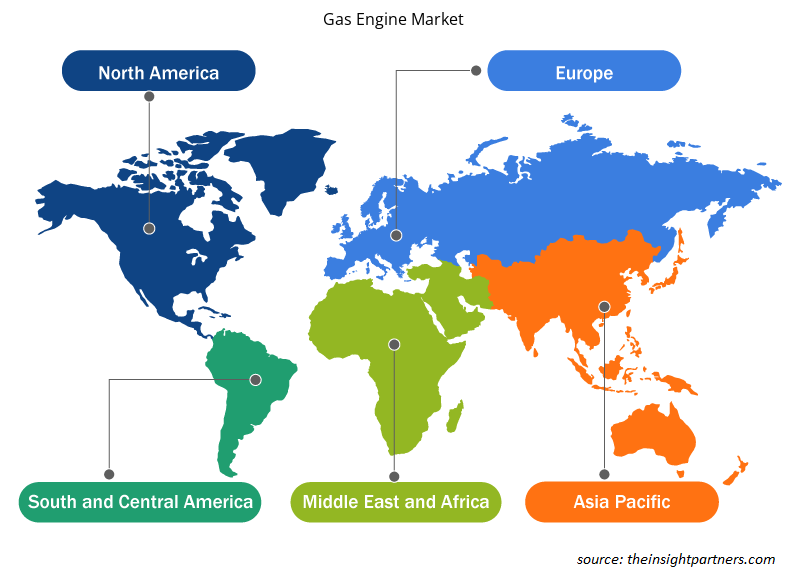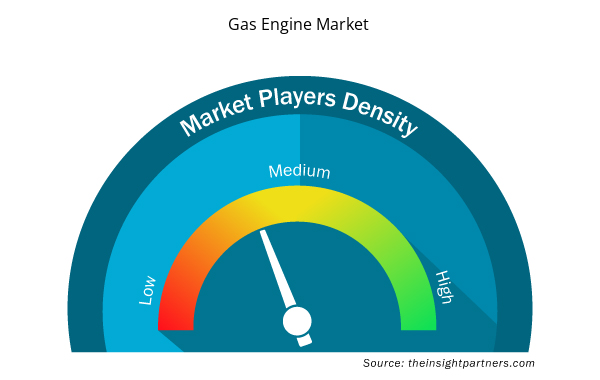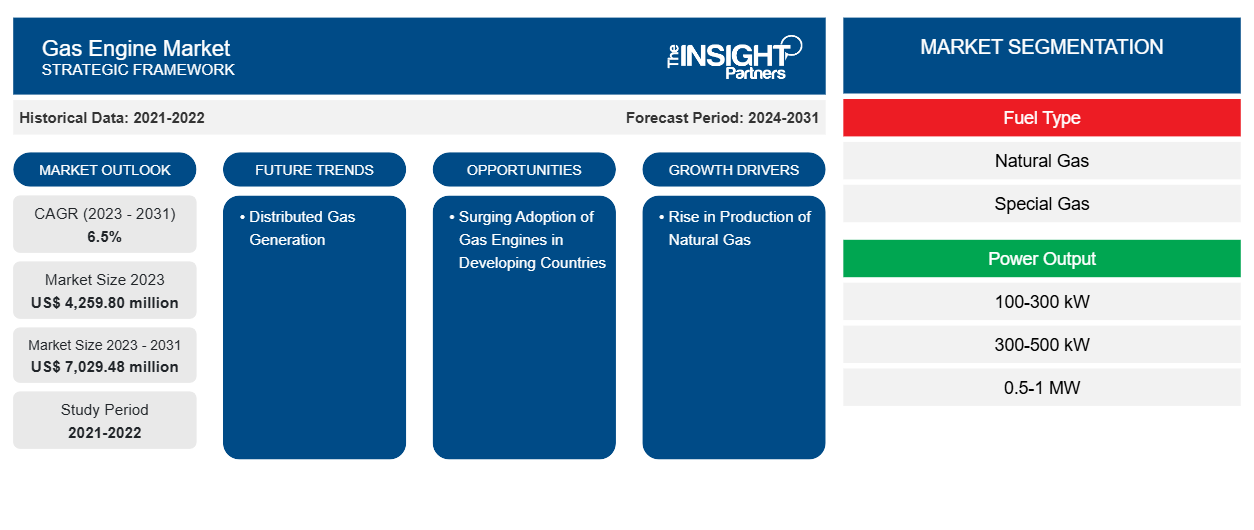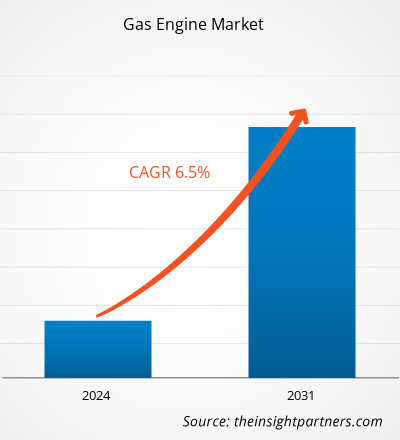ガスエンジン市場規模は、2023年の42億5,980万米ドルから2031年には70億2,948万米ドルに達すると予測されています。市場は2023年から2031年にかけて6.5%のCAGRを記録すると予想されています。産業、建設、商業部門での発電用天然ガスの採用拡大は、ガスエンジン市場の主要なトレンドであり続けると思われます。
ガスエンジン市場分析
金属、化学、食品加工などの重工業における天然ガス駆動エンジンの需要拡大が、市場を急速に牽引しています。さらに、排出ガスに関する懸念の高まりと規制基準の強化が市場の成長を支えています。ガスエンジン市場では、ミッドストリーム石油・ガス、遠隔地、重工業、軽工業、公益事業、バイオガス、データセンター、MUSH、商業がエンドユーザーです。
ガスエンジン市場の概要
各国の政府はディーゼルエンジンやガソリンエンジンの排出ガスを制御するための特定の規制を実施しており、そのためエンジンメーカーは天然ガスなどの代替燃料ソリューションを選択するようになっています。ガスエンジンは、十分な量の電力を高い能力で生成するために、より少ない排出物を放出します。各国の排出監視およびモニタリング協会は、ディーゼルエンジンと発電機の使用に対して厳しい規制を施行しています。これらの規制ガイドラインを満たすために、多くの産業が発電にガスエンジンと発電機を採用しています。大規模および中規模の企業は、独自の電力を生成することでコストを制御するために、分散型発電の実践に移行しています。企業はすでに電源バックアップまたは追加の電力ニーズのためにガスエンジンを採用しており、分散型ガス発電の出現はガスエンジン市場の重要なトレンドとして浮上しています。
要件に合わせてレポートをカスタマイズする
このレポートの一部、国レベルの分析、Excelデータパックなど、あらゆるレポートを無料でカスタマイズできます。また、スタートアップや大学向けのお得なオファーや割引もご利用いただけます。
- このレポートの主要な市場動向を入手してください。この無料サンプルには、市場動向から見積もりや予測に至るまでのデータ分析が含まれます。
ガスエンジン市場の推進要因と機会
天然ガス需要の増加がガスエンジン市場を後押し
ガスエンジンの需要は、新しい排出規制政策により、発電業界で高まっています。金属、化学、製造業などの産業部門は、ガスエンジンの需要の加速に大きく貢献しています。ガスエンジンの動作に必要な天然ガスの生成は、かなりの速度で増加しています。発電、暖房、車両機能などの主要な用途では、天然ガスエンジンの必要性が高まっています。したがって、突然の停電に解決策を提供するために、公益事業サービス会社はピーク負荷を管理するためにガス発電機を利用しています。したがって、発展途上国と先進国からの需要の絶え間ない急増は、ガスエンジン市場の成長を促進する重要な要因の1つです。
発展途上国におけるガスエンジンの導入増加 - ガスエンジン市場におけるチャンス
人口の増加と電気技術を支えるインフラの欠如は、ガスエンジン市場を支える主な要因です。電気機器、電動モーター、太陽光発電所、風力発電プロジェクトはガスエンジンよりもコストがかかるため、さまざまな国が環境に優しい代替手段としてガスエンジンを好んでいます。さらに、ディーゼルエンジンの排出基準の発展により、さまざまな最終用途産業が排出量の少ないガスエンジンに移行しています。新興国は、事実上、発電に天然ガスを採用する傾向にあります。したがって、天然ガスの人気の高まりは、ガスエンジン市場に有利な機会を提供することが期待されます。
ガスエンジン市場レポートのセグメンテーション分析
ガスエンジン市場分析の導出に貢献した主要なセグメントは、燃料の種類、出力、およびエンドユーザーです。
- 燃料の種類に基づいて、ガスエンジン市場は天然ガスと特殊ガスに分けられています。天然ガスセグメントは2023年に大きな市場シェアを占めました。
- 出力別に見ると、市場は100~300kW、300~500kW、0.5~1MW、1~2MW、2~5MW、5~10MW、10~20MWに区分されています。2023年には300~500kWのセグメントが市場を支配しました。
- エンドユーザーの観点から、市場はリモート(鉱業、掘削、その他)、ミッドストリーム石油・ガス、重工業(化学、製紙、金属、食品・飲料、その他)、軽工業、公益事業(グリッド、IPP、その他)、バイオガス、データセンター、MUSH、商業に分類されています。 2023年には重工業セグメントが市場を支配しました。
地域別ガスエンジン市場シェア分析
ガスエンジン市場レポートの地理的範囲は、主に北米、アジア太平洋、ヨーロッパ、中東およびアフリカ、南米/中南米の 5 つの地域に分かれています。
ヨーロッパのガスエンジン市場は、英国、ドイツ、イタリア、フランス、ロシア、その他のヨーロッパにさらに細分化されています。ドイツ、フランス、英国、イタリアは、ヨーロッパのガスエンジン市場の主要国です。ユーティリティ、リモートセクター、産業機器向けのガスエンジンの積極的な採用は、ヨーロッパのガスエンジン市場をリードする可能性があります。また、INNIOやLiebherrなど、ヨーロッパ地域の著名なエンジンメーカーの強力な存在は、市場の拡大を促しています。厳しい汚染規制とディーゼルエンジンの汚染の増加により、産業とユーティリティセクターはエンジンに天然ガスを利用するよう促されており、これも市場の発展にプラスの影響を与えています。
ガスエンジン市場の地域別分析
予測期間を通じてガスエンジン市場に影響を与える地域的な傾向と要因は、Insight Partners のアナリストによって徹底的に説明されています。このセクションでは、北米、ヨーロッパ、アジア太平洋、中東、アフリカ、南米、中米にわたるガスエンジン市場のセグメントと地理についても説明します。

- ガスエンジン市場の地域別データを入手
ガスエンジン市場レポートの範囲
| レポート属性 | 詳細 |
|---|---|
| 2023年の市場規模 | 42億5,980万米ドル |
| 2031年までの市場規模 | 70億2,948万米ドル |
| 世界のCAGR(2023年~2031年) | 6.5% |
| 履歴データ | 2021-2022 |
| 予測期間 | 2024-2031 |
| 対象セグメント | 燃料の種類別
|
| 対象地域と国 | 北米
|
| 市場リーダーと主要企業プロフィール |
|
市場プレーヤーの密度:ビジネスダイナミクスへの影響を理解する
ガスエンジン市場は、消費者の嗜好の変化、技術の進歩、製品の利点に対する認識の高まりなどの要因により、エンドユーザーの需要が高まり、急速に成長しています。需要が高まるにつれて、企業は提供を拡大し、消費者のニーズを満たすために革新し、新たなトレンドを活用し、市場の成長をさらに促進しています。
市場プレーヤー密度とは、特定の市場または業界内で活動している企業または会社の分布を指します。これは、特定の市場スペースに、その市場規模または総市場価値に対してどれだけの競合相手 (市場プレーヤー) が存在するかを示します。
ガスエンジン市場で事業を展開している主要企業は次のとおりです。
- イェンバッハ株式会社
- キャタピラー社
- カミンズ社
- フェアバンクス・モース有限責任会社
- 川崎重工業株式会社
- リープヘル
免責事項:上記の企業は、特定の順序でランク付けされていません。

- ガスエンジン市場のトップキープレーヤーの概要を入手
ガスエンジン市場のニュースと最近の動向
ガスエンジン市場は、主要な企業出版物、協会データ、データベースを含む一次調査と二次調査後の定性的および定量的データを収集することによって評価されます。以下は、イノベーション、ビジネス拡大、および戦略に関する市場の開発のリストです。
- 2023年2月、カミンズ社は、燃料に依存しないシリーズの次期エンジンであるX10を2026年に北米で導入すると発表しました。(出典:カミンズ社、プレスリリース/企業ウェブサイト/ニュースレター)
- 三菱重工業グループの三菱重工エンジン&ターボチャージャ株式会社は、2023年3月、発電出力2,000kWの新型天然ガスエンジンコージェネレーションシステム「SGP M2000」を導入した。(出典:三菱重工業グループ、プレスリリース/企業ウェブサイト/ニュースレター)
ガスエンジン市場レポートの対象範囲と成果物
「ガスエンジン市場の規模と予測(2021〜2031年)」レポートでは、以下の分野をカバーする市場の詳細な分析を提供しています。
- ガスエンジン市場規模と予測、および対象範囲に含まれるすべての主要市場セグメントの世界、地域、国レベルでの予測
- 市場の動向(推進要因、制約、主要な機会など)
- ガスエンジン市場の動向
- 詳細なPESTおよびSWOT分析
- 主要な市場動向、世界および地域の枠組み、主要プレーヤー、規制、最近の市場動向を網羅したガスエンジン市場分析
- ガスエンジン市場業界、ランドスケープ、競争分析、市場集中、ヒートマップ分析、主要プレーヤー、最近の動向
- 詳細な企業プロフィール
- 過去2年間の分析、基準年、CAGRによる予測(7年間)
- PEST分析とSWOT分析
- 市場規模価値/数量 - 世界、地域、国
- 業界と競争環境
- Excel データセット



Report Coverage
Revenue forecast, Company Analysis, Industry landscape, Growth factors, and Trends

Segment Covered
This text is related
to segments covered.

Regional Scope
North America, Europe, Asia Pacific, Middle East & Africa, South & Central America

Country Scope
This text is related
to country scope.
Trends and growth analysis reports related to Energy and Power : READ MORE..
The Insight Partners performs research in 4 major stages: Data Collection & Secondary Research, Primary Research, Data Analysis and Data Triangulation & Final Review.
- Data Collection and Secondary Research:
As a market research and consulting firm operating from a decade, we have published and advised several client across the globe. First step for any study will start with an assessment of currently available data and insights from existing reports. Further, historical and current market information is collected from Investor Presentations, Annual Reports, SEC Filings, etc., and other information related to company’s performance and market positioning are gathered from Paid Databases (Factiva, Hoovers, and Reuters) and various other publications available in public domain.
Several associations trade associates, technical forums, institutes, societies and organization are accessed to gain technical as well as market related insights through their publications such as research papers, blogs and press releases related to the studies are referred to get cues about the market. Further, white papers, journals, magazines, and other news articles published in last 3 years are scrutinized and analyzed to understand the current market trends.
- Primary Research:
The primarily interview analysis comprise of data obtained from industry participants interview and answers to survey questions gathered by in-house primary team.
For primary research, interviews are conducted with industry experts/CEOs/Marketing Managers/VPs/Subject Matter Experts from both demand and supply side to get a 360-degree view of the market. The primary team conducts several interviews based on the complexity of the markets to understand the various market trends and dynamics which makes research more credible and precise.
A typical research interview fulfils the following functions:
- Provides first-hand information on the market size, market trends, growth trends, competitive landscape, and outlook
- Validates and strengthens in-house secondary research findings
- Develops the analysis team’s expertise and market understanding
Primary research involves email interactions and telephone interviews for each market, category, segment, and sub-segment across geographies. The participants who typically take part in such a process include, but are not limited to:
- Industry participants: VPs, business development managers, market intelligence managers and national sales managers
- Outside experts: Valuation experts, research analysts and key opinion leaders specializing in the electronics and semiconductor industry.
Below is the breakup of our primary respondents by company, designation, and region:

Once we receive the confirmation from primary research sources or primary respondents, we finalize the base year market estimation and forecast the data as per the macroeconomic and microeconomic factors assessed during data collection.
- Data Analysis:
Once data is validated through both secondary as well as primary respondents, we finalize the market estimations by hypothesis formulation and factor analysis at regional and country level.
- Macro-Economic Factor Analysis:
We analyse macroeconomic indicators such the gross domestic product (GDP), increase in the demand for goods and services across industries, technological advancement, regional economic growth, governmental policies, the influence of COVID-19, PEST analysis, and other aspects. This analysis aids in setting benchmarks for various nations/regions and approximating market splits. Additionally, the general trend of the aforementioned components aid in determining the market's development possibilities.
- Country Level Data:
Various factors that are especially aligned to the country are taken into account to determine the market size for a certain area and country, including the presence of vendors, such as headquarters and offices, the country's GDP, demand patterns, and industry growth. To comprehend the market dynamics for the nation, a number of growth variables, inhibitors, application areas, and current market trends are researched. The aforementioned elements aid in determining the country's overall market's growth potential.
- Company Profile:
The “Table of Contents” is formulated by listing and analyzing more than 25 - 30 companies operating in the market ecosystem across geographies. However, we profile only 10 companies as a standard practice in our syndicate reports. These 10 companies comprise leading, emerging, and regional players. Nonetheless, our analysis is not restricted to the 10 listed companies, we also analyze other companies present in the market to develop a holistic view and understand the prevailing trends. The “Company Profiles” section in the report covers key facts, business description, products & services, financial information, SWOT analysis, and key developments. The financial information presented is extracted from the annual reports and official documents of the publicly listed companies. Upon collecting the information for the sections of respective companies, we verify them via various primary sources and then compile the data in respective company profiles. The company level information helps us in deriving the base number as well as in forecasting the market size.
- Developing Base Number:
Aggregation of sales statistics (2020-2022) and macro-economic factor, and other secondary and primary research insights are utilized to arrive at base number and related market shares for 2022. The data gaps are identified in this step and relevant market data is analyzed, collected from paid primary interviews or databases. On finalizing the base year market size, forecasts are developed on the basis of macro-economic, industry and market growth factors and company level analysis.
- Data Triangulation and Final Review:
The market findings and base year market size calculations are validated from supply as well as demand side. Demand side validations are based on macro-economic factor analysis and benchmarks for respective regions and countries. In case of supply side validations, revenues of major companies are estimated (in case not available) based on industry benchmark, approximate number of employees, product portfolio, and primary interviews revenues are gathered. Further revenue from target product/service segment is assessed to avoid overshooting of market statistics. In case of heavy deviations between supply and demand side values, all thes steps are repeated to achieve synchronization.
We follow an iterative model, wherein we share our research findings with Subject Matter Experts (SME’s) and Key Opinion Leaders (KOLs) until consensus view of the market is not formulated – this model negates any drastic deviation in the opinions of experts. Only validated and universally acceptable research findings are quoted in our reports.
We have important check points that we use to validate our research findings – which we call – data triangulation, where we validate the information, we generate from secondary sources with primary interviews and then we re-validate with our internal data bases and Subject matter experts. This comprehensive model enables us to deliver high quality, reliable data in shortest possible time.


 このレポートの無料サンプルを入手する
このレポートの無料サンプルを入手する